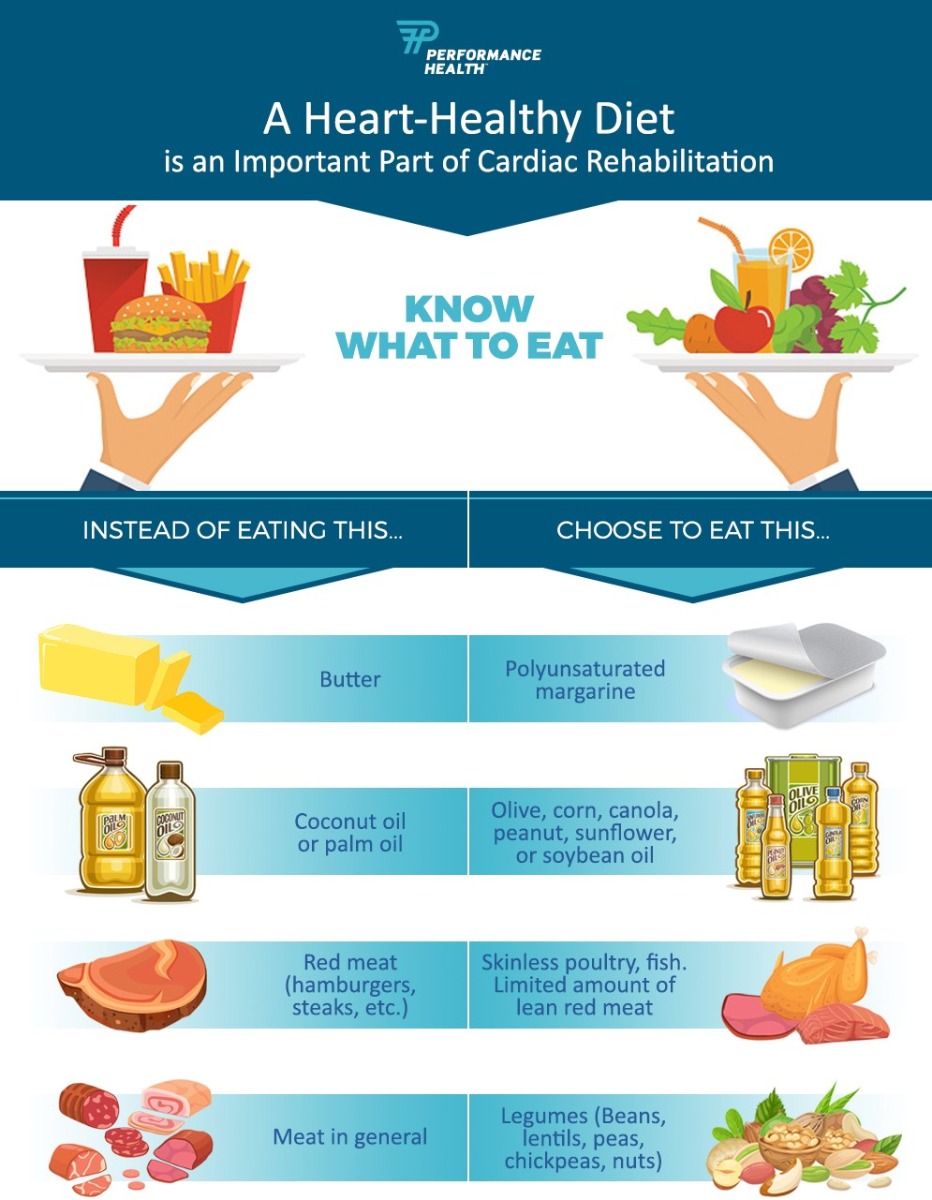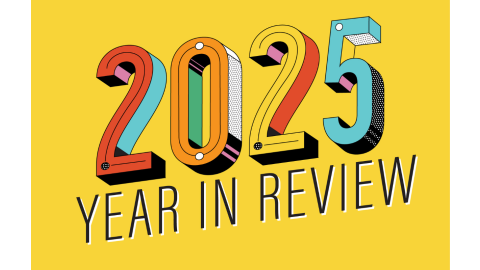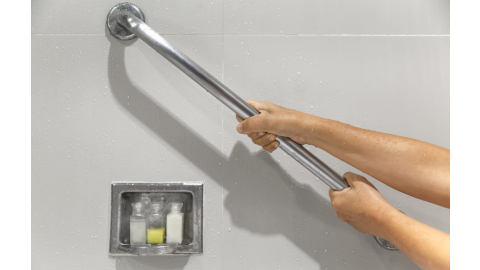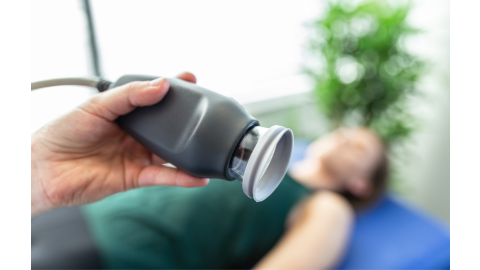Cardiac rehabilitation helps improve your heart health. Proper nutrition and other healthy habits are a key part of this program. Learn about simple changes you can make to stay healthy!
Nutrition
Why Proper Nutrition Matters
Good nutrition can reduce your risk of heart attack or stroke.1 That’s why learning about the most nutritious foods for a heart-healthy diet is so important. During cardiac rehabilitation, you’ll receive guidance on the best food choices to keep your heart healthy.
Basic Nutrition Do’s and Don’ts
Know the number of calories you should eat depending on whether your goal is to maintain or lose weight. Try to cook at home so you know the ingredients that are being used in your food.
Do Eat
- Whole grains
- A variety of fruits and vegetables
- Nuts and legumes (almonds, peanuts, walnuts, peas, beans, and more)
- Low-fat dairy products
- Fish containing omega-3 fatty acids (salmon, trout, herring, fresh tuna)
Don’t Eat (or Limit)
- Foods high in saturated fat, trans fat, or sodium
- Red meat
- Sweets
- Sugary beverages
Eat This, Not That


Why Certain Nutrients Are Bad for Your Heart
To keep your heart healthy, you should avoid certain nutrients including:
- Saturated fat
- Saturated fat raises the level of LDL cholesterol in your blood, increasing your risk of atherosclerosis, heart disease, and stroke. It’s commonly found in meat, dairy products, baked goods, and fried foods.
- Trans fat
- Trans fat (listed as partially hydrogenated oils in processed food) increases your risk of heart disease, stroke, and type II diabetes. Trans fat is found in fast food restaurants that use them to fry foods. It is also in fried foods like donuts, and baked goods, including cakes, cookies, frozen pizzas, crackers, and stick margarines.
- Sodium
- Extra sodium can lead to high blood pressure. It’s known as a “silent killer” and one of the major risk factors for heart disease. Most sodium comes from packaged, processed, and restaurant food. Limit your intake of foods high in sodium, including the “salty six” ( bread and rolls, cold cuts, soup, pizza, burritos and tacos, and chicken) the foods that add the most salt to your diet.
- Sugar
- Limiting your sugar intake is an important part of a heart-healthy lifestyle. Reduce the amount of candy, baked goods, syrup, soda, and other sugary food and drinks you consume.
Quit Smoking
Why Smoking is Bad for Your Heart
Smoking increases your risk of dying from coronary heart disease and increases the effects of high blood pressure and high cholesterol. Ready to quit? Improve your health and quit for good by following these steps.
Quit Smoking for Good in 5 Easy Steps
- Choose your “Quit Day”. Pick a date in the next seven days when you’ll stop using tobacco products for good, then take the pledge in front of supportive friends/family.
- Choose your method for quitting. There are three ways to prepare for your Quit Day. Follow the method below that you think will work best for you.
- Talk with your doctor and decide if you should use medicine to help you quit.
- Make a plan for your Quit Day and afterwards. Have healthy snacks to eat (fruits, veggies, popcorn, gum) and a plan to fill your time when you’re tempted to smoke. See a movie, go for a walk, paint, work in the yard, or enjoy other activities that keep your mind and hands busy. Get rid of any cigarettes, vapes, matches, lighters, ashtrays, and tobacco products at home, work, and in your car.
- Quit smoking for good on your Quit Day!
3 Methods to Quit Smoking
- Go “cold turkey”. Completely stop smoking, vaping, and using tobacco on your Quit Day. This keeps the process from dragging out.
- Cut down on the number of cigarettes you smoke each day leading up to your Quit Day. For example, if you normally smoke 20 cigarettes a day, cut down to 10, then 5, until your Quit Day when you stop completely. This acclimates you to gradually filling the time you used to spend smoking.
- Cut down on how much of each cigarette you smoke. Count how many puffs you usually take from a cigarette. Then cut down on the number of puffs until your Quit Day when you stop completely. This method slowly cuts down on your smoking while keeping your old schedule in place.
Keeping track on a calendar can help you commit to and follow your plan.
Heart-Healthy Habits
Little changes can make a big difference when it comes to your heart health. Start a healthier lifestyle today by committing to a nutritious diet and a tobacco free life. Cardiac rehabilitation can teach you more about forming and keeping these new healthy habits.
Create other healthy habits by:
References
- American Heart Association. (2018). Eating Well and Losing Weight. Retrieved from https://bit.ly/2XctJY5
- American Heart Association. (2015). The American Heart Association Diet and Lifestyle Recommendations. Retrieved from https://bit.ly/2Azjt6g
- Hillingdon Hospital NHS Trust. (n.d.). Information for Patients Following Heart Attack. Retrieved from https://bit.ly/30bVO3V
- American Heart Association. (2015). Saturated Fat. Retrieved from https://bit.ly/2BvP6fs
- American Heart Association. (2017). Trans Fat. Retrieved from https://bit.ly/2ZXEu2e
- American Heart Association. (2018). Get the Scoop on Sodium and Salt. Retrieved from https://bit.ly/2HgNrOf
- American Heart Association. (2018). Tips for Cutting Down on Sugar. Retrieved from https://bit.ly/2O4cDJc
- American Heart Association. (2018). Taking Care of Yourself. Retrieved from https://bit.ly/2RBuBXB
- American Heart Association. (2018). 5 Steps to Quit Smoking. Retrieved from https://bit.ly/2S0uFRy
Medical Disclaimer: The information provided on this site, including text, graphics, images and other material, are for informational purposes only and are not intended to substitute for professional medical advice, diagnosis or treatment. Always seek the advice of your physician or other healthcare professional with any questions or concerns you may have regarding your condition.








 France
France Australia
Australia






